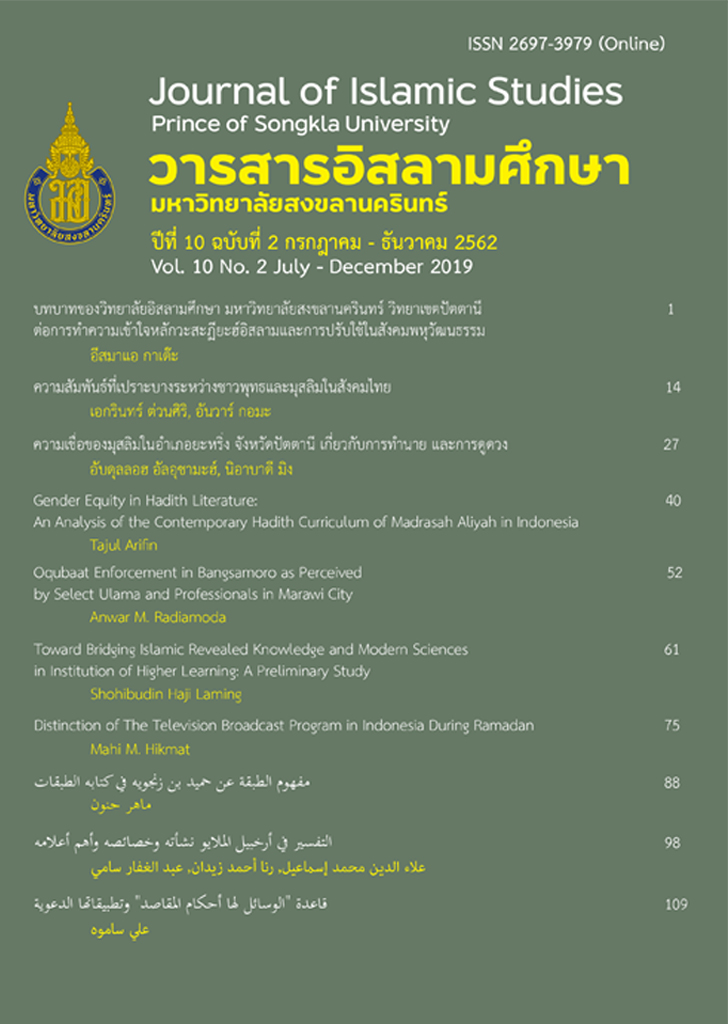Gender Equity in Hadith Literature: An Analysis of the Contemporary Hadith Curriculum of Madrasah Aliyah in Indonesia
คำสำคัญ:
Gender equity, Hadith, Hadith Curriculumบทคัดย่อ
This paper was stimulated by the fact that Muslim women participation in education in Indonesia is still lower than that in neighbouring’s countries. This condition has been influenced by the weak support of Hadith Curriculum of Madrasah Aliyah toward gender equity. This condition has been misunderstood by some scholars that Hadith does not support gender equity. The aims of this paper are to give a clear picture of gender equity in Hadith literature and analyze the content of Hadith Curriculum of Madrasah Aliyah in Indonesia in relation to gender equity support. This research applied descriptive analytic method. Data were gained through Hadith literature and Hadith Curriculum of Madrasah Aliyah, Year 2013. This study revealed that Hadith strongly support gender equity in all aspects of life achieved as in economic, social, and political aspects. In addition, Hadith Curriculum of Madrasah Aliyah does not strongly support the emergence of strong and positive thinking toward gender equity among the students of Madrasah Aliyah most of whom then becoming religious leaders in Indonesian society. The implication of this finding requires us to make changes in the content structure of the Curriculum of Hadith for Madrasah Aliyah in Indonesia.
เอกสารอ้างอิง
Abu Dawud, S. (n.d.). Sunan Abu Dawud. Bandung: Dahlan.
Adriana, I. (2015). Kurikulum Berbasis Gender (Membangun Pendidikan Yang Berkesetaraan). TADRIS: Jurnal Pendidikan Islam, 4(1). Retrieved from http://ejournal.stainpamekasan.ac.id/index.php/tadris
Ali, Y. (n.d.). The Holy Qur’an, English Translation of the Meanings and Commentary. Al-Madinah Al-Munawarah: King Fahd Holy Qur’an Printing Complex.
Bukhari, A. A. (n.d.). Matan Shahih al-Bukhari. Egypth: Isa al-Babi al-Halabi wa Syurakah.
Durkheim, E. & Lukes, S. (n.d.). The Divison of Labor in Society. London: Free Press.
Habibullah, H. (2014). Refleksi Gender dalam Pembelajaran Kurikulum 2013; Studi terhadap Hasil Belajar IPS Siswa Kelas Model di Solok, Sumatera Barat. Kafa`ah: Journal of Gender Studies, 4(2). https://doi.org/10.15548/jk.v4i2.100
International Labour Organization. (2000). ABC of women workers, rights, and gender equality (Second edi). Geneva: International Labour Office.
Kementerian Agama R. (2013). Peraturan Menteri Agama RI Nomor 912 Tahun 2013 tentang Kurikulum Madrasah 2013. Jakarta: Kementerian Agama RI.
Khotimah, K. (2015). Urgensi Kurikulum Gender dalam Pendidikan. Insania, 13(3). Retrieved from http://ejournal.iainpurwokerto.ac.id/index.php/insania
Komarudin, O. (2016). Kritik terhadap Kurikulum Berbasis Kesetaraan Gender. AT TA’DIB, 9(2). Retrieved from http://ejournal.unida.gontor.ac.id/index.php/tadib
Laylisna, N. N. (2016). English for Indonesian: Designing Curriculum Development Based on Gender Equality. Jurnal Al Hikmah, 4(1). Retrieved from http://jurnal.staiba.ac.id/index.php/alhikmah
Mustaqim, M. (2014). Kurikulum Pendidikan Dasar Berperspektif Gender. EDUKASIA, 11(2). Retrieved from http://journal.stainkudus.ac.id/index.php/Edukasia
Nurmila, N. (2018). Fiqih Kontemporer Berperespektif Keadilan Gender. In Orasi Ilmiah Pengukuhan Guru Besar. Bandung: Fakultas Tarbiyah dan Keguruan UIN Sunan Gunung Djati Bandung.
Olsen, J., & Sen, S. (2014). On the rationality of cycling in the Theory of Moves framework. Connection Science, 26(2), 141–160. Retrieved from https://doi.org/10. 1080/ 09540091.2014.885298
Sagaf, P. (2009). Gender Education (Rekonstruksi Pendidikan Yang Bias Gender). MUSAWA, 1(2). Retrieved from http://jurnal.iainpalu.ac.id/index.php/musawa
Said, N. (2010). Pendidikan Karakter Berkeadilan Gender (Suatu Tinjauan Pengembangan Ide Kurikulum). PALASTREN, 3(1). Retrieved from http://journal.stainkudus.ac.id/index.php/Palastren
Sorokin, P. (1941). Social and Cultural Dynamics. New York: American Book Company.
Spencer, H. (2005). The study of sociology. Michigan: University of Michigan Library.
Susilowati, M. (2012). A Gender Awareness Hidden Curriculum to Promote Gender Equality at Primary Schools in Indonesia. Egalita, 2(2). Retrieved from http://ejournal.uin-malang.ac.id/index.php/egalita
Toynbee, A. J. (1945). A Study of History. London: Oxford University Press. Retrieved from https://scholar.google.co.id/scholar?q=Daftar+Pustaka+Toynbee+A+Study+of+History+&btnG=&hl=id&as_sdt=0%2C5&as_vis=1\
ดาวน์โหลด
เผยแพร่แล้ว
รูปแบบการอ้างอิง
ฉบับ
ประเภทบทความ
สัญญาอนุญาต
บทความทุกเรื่อง ที่ได้รับการตีพิมพ์ในวารสารอิสลามศึกษาเป็นแนวคิดของผู้เขียน มิใช่เป็นความคิดเห็นคณะผู้จัดทำและมิใช่ความรับผิดชอบของคณะวิทยาการอิสลาม กองบรรณาธิการไม่สงวนสิทธิ์การคัดลอก แต่ให้มีการอ้างอิงแสดงที่มา




